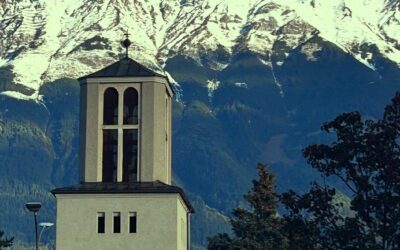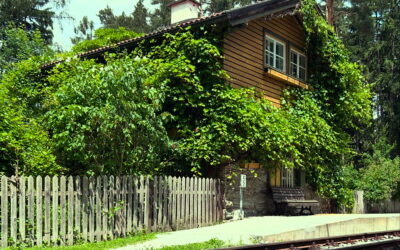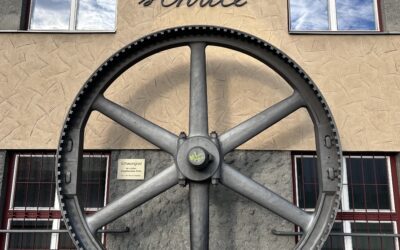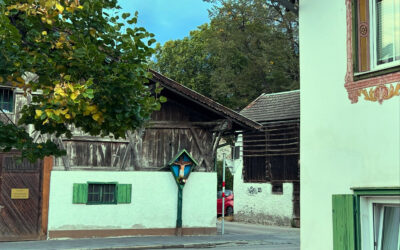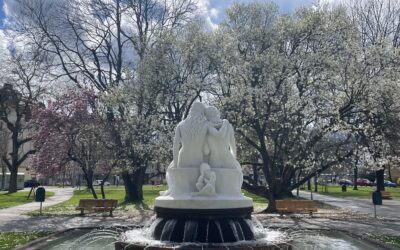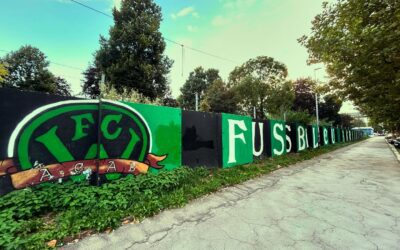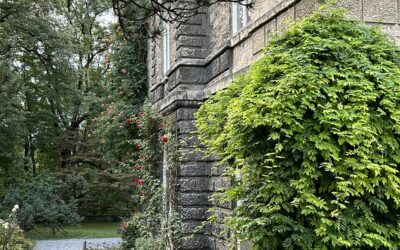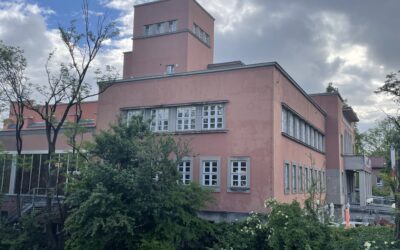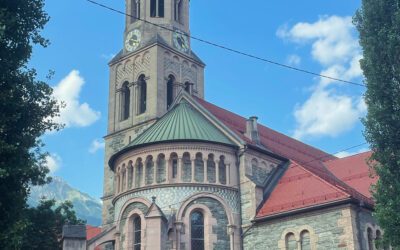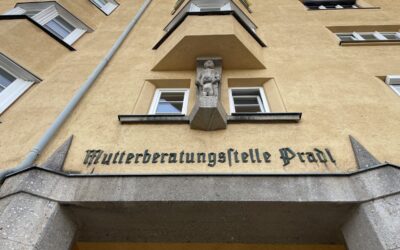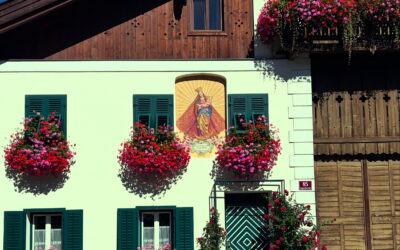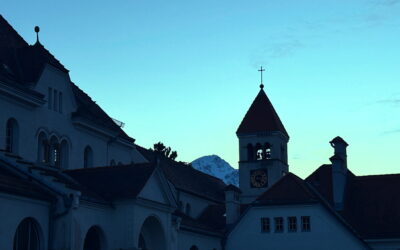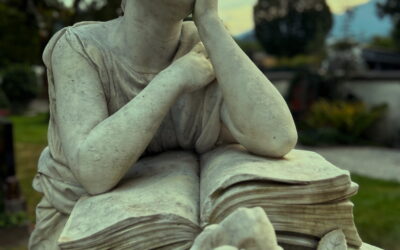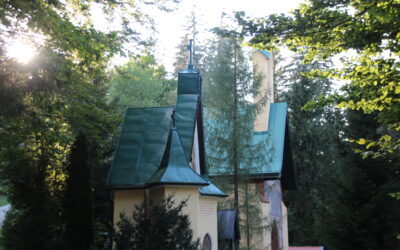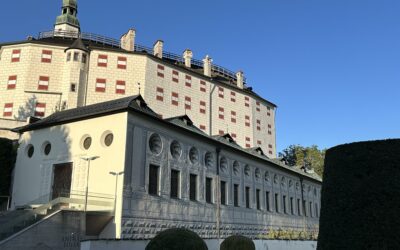Pradl & Amras
Things to know about Pradl
The name Pradl probably goes back to the Latin expression Pratellumwhich refers to a Roman settlement in the area. According to the Innsbruck city chronicle, the name Pradl was first mentioned in a document in 1178. Until the industrialisation of the 19th century, Pradl was a collection of farms to the east of Innsbruck. In the 19th century, when the cotton spinning mill Herrburger und Rhomberg (1839), the Epp soap factory (1885) and the gasworks (1859), the village grew rapidly. In 1900, what is now Innsbruck's largest district already had around 2000 inhabitants. The gasworks on the site of today's Rapoldipark in particular changed the face of Pradl. By the time the railway station was built, the town had grown to its limits and the village had become the most important location for energy and infrastructure. In 1861, the town began to be illuminated with gas lights. At the turn of the century, Innsbruck was lit by over 500 gas lights. More and more kitchens were also fuelled by gas. The main problem with gas production was that it was achieved by burning coal. Smoke and dust polluted the air right next to the houses and farms. While Innsbruck benefited from industrialisation, Pradl mainly felt the negative aspects of it: overpopulation, rapid transformation of the social fabric and dirt were the consequences of this development. The village was unable to enjoy the positive aspects of modernisation. Despite the growth, there was a lack of money to upgrade the infrastructure. There were hardly any sewers, roads, schools, health care or even public transport. The drinking water was still spreading typhoid in the 20th century and there was little or no sign of modernisation.
In 1904, the village became a district. Until then, Pradl and its southern neighbour Amras had formed a municipality. At a citizens' meeting in 1902, a large majority of the people of Pradl voted in favour of the merger. In Amras, on the other hand, the majority were against the incorporation, which is why Pradl first had to secede from Amras in order to become part of Innsbruck. From 1912, the tram connected Pradl with the city centre. From the former town centre at Florianibrunnen wurden nach Süden hin Zinshäuser im Heimatstil oder dem klassizistischen Historismus als Wohnstätten für die Arbeiter und Angestellten gebaut. Auch an der Sill bestehen einige der Gebäude bis heute. Die großen Wohnanlagen weiter im Osten in der Pembaurstraße oder der Gabelsbergerstraße wurden nach den damals neuesten Erkenntnissen in der Architektur mit geräumigen Innenhöfen und viel Grün angelegt. Der soziale Wohnbau wurde von seinem architektonischen Vertreter in Innsbruck Theodor Prachensky nicht nur quantitativ, sondern auch qualitativ weiterentwickelt. Die Fabriksarbeiter hatten, obwohl sie immer noch zu den ärmeren Bevölkerungsteilen zählten, nicht das Los der Verelendung zu teilen, das dem Proletariat in anderen großen Städten durch den ungezügelten Kapitalismus zugemutet wurde. Das war wohl neben der kirchlichen Dominanz mit ein Grund, warum Kommunismus und Sozialismus in Tirol nur gebremst Fahrt aufnahmen. 1927 wurde, um ärgsten der sozialen Not der Nachkriegszeit ein wenig entgegenzuwirken, das Obdachlosenheim in der Hunoldstraße eröffnet. Zur selben Zeit entstanden zwischen Pradl und Amras die unter Einheimischen als „Stalingrad“ bekannten Kaufmannblöcke im Internationalen Stilwhich, with their inner courtyards and cubic form, are now listed buildings. Between 1939 and 1945, the Südtirolersiedlungen im Osten Pradls gebaut. Eichhof, Ahornhof und Lindenhof still characterise the image of Pradl today with their large inner courtyards. Perhaps the biggest change in Pradl was the redevelopment of the Tivoli area in 2000, where fans and players of Innsbruck's football clubs used to party and celebrate, a completely new neighbourhood was created with over 400 flats, a retirement home, kindergarten, playground, supermarkets, office buildings and a skateboard park.
Things to know about Amras
The neighbouring district of Amras can be traced back even further than Pradl. The village was built below today's Ambras Castle. It was first mentioned in writing in 837 as „locus omeras". The name probably goes back to the shady location. The Latin Ad umbras means nothing other than "by the shadows". The Counts of Andechs built their castle of the same name here a little later. Omeras probably goes back to the shady location at the foot of the Patscherkofel and the Latin stem ad umbrasback to the shadows. Amras was a settlement with its own administration, a typical rural Tyrolean village. Until 1256, Amras did not belong to Wilten Abbey, but to Ampass.
Where the DEZ shopping centre now adjoins the old village, there was the Amraser See lake until the 19th century, which gradually became marshy and is now only remembered in old pictures and from the Amraser-See-Straße. Emperor Maximilian had fish bred here to make it easier for himself and his court to starve on Christian fasting days. Until the 1960s, you could spend your holiday at the Seewirt campsite before the meadows and open spaces were sealed off for the benefit of consumption in the typical manner of the car-centred urban development of the post-war economic boom.
According to an art historical study by Wilhelm Fischer from 1951, the famous painting gives an impression of early modern Amras Winterlandschaft des niederländischen Malers Pieter Bruegel (circa 1525 – 1569), das im Wiener Kunsthistorischen Museum hängt. Bruegel war neben dem apokalyptisch veranlagten Hieronymus Bosch der bekannteste Vertreter der flämischen Malerei der Zeit um 1500. Zwischen 1552 und 1555 hatte er sich nach seiner Ausbildung in Antwerpen nach Italien begeben, um sich dort im Geist der Zeit mit der Renaissancekunst zu beschäftigen. Diese Zeit ging als Anfang der Kleinen Eiszeit, die sich vom 15. Jahrhundert in unterschiedlicher lokaler Ausprägung bis ins 19. Jahrhundert zog, in die Geschichte ein. Auch in Tirol sorgte dieser kleine Klimawandel für eine höhere Quote an Ernteausfällen und zu großen wirtschaftlichen Verwerfungen und Versorgungsengpässen. Auf seiner Rückreise nach Nordeuropa machte Bruegel wie viele Zeitgenossen in Innsbruck Rast und ließ sich von Landschaft und Menschen inspirieren. Anders als wenige Jahre zuvor Albrecht Dürer auf seinem bekannten Aquarell, das eine Stadtansicht Innsbrucks zeigt, hielt er wie auf den meisten seiner Bilder eine Alltagsszene fest. Zwar siedelt er die Szene in den Niederlanden an, wie man an einigen Details wie dem Schild des Gasthofes erkennen kann, die winterliche, alpine Landschaft passt aber recht genau in die Perspektive, die man vom heutigen Ortsteil mit Blick nach Norden hat. Im Vordergrund sieht man eine Jagdgesellschaft, die mutmaßlich vom damals noch nicht ummauerten Schloss Ambras ins Inntal zurückkehrt. Im Hintergrund tummeln sich Erwachsene und Kinder beim Eislaufen und Spielen am See vor der Kulisse des Karwendels und des Inntals. Das bäuerliche Dorf Amras und das Treiben darin scheinen den Meister nachhaltig genug beeindruckt zu haben, dass er zurück in der Heimat das Erlebte zwölf Jahre später in Öl festhielt. Ob die eislaufenden Bauern nun Tiroler oder Flamen, die Bruegel in eine Tiroler Szenerie versetzte, sind, soll uns nicht weiter kümmern.
1938, also 34 Jahre nach Pradl wurde Amras im Rahmen der reichsweiten Eingliederungen unter den Nationalsozialsten in Innsbruck eingemeindet. Der Bau von größeren urbanen Wohnhäusern nahm erst später seinen Anfang, was sich im Baustil niederschlägt. Während in Pradl viele Häuser aus der Zeit um die Jahrhundertwende stammen, werden die Wohnblöcke in Amras von der Nachkriegsarchitektur dominiert. Ur-Amraser fühlen sich bis heute noch vielfach als Bewohner eines eigenen Dorfes, Innsbrucker ist man nur im zweiten Rang. Im Osten der Philippine-Welser-Straße befinden sich einige der schönen Bauernhäuser, die den Stadtteil im Amraser Selbstverständnis ebenso darstellen wie den Wohlstand, zu dem die Landwirte mittlerweile gekommen sind. Östlich an Amras schließt das Innsbrucker Gewerbegebiet mit dem Einkaufszentrum DEZ an. Das DEZ bildet den Endpunkt der Hauptverkehrsader Südring, der von West nach Ost den Großteil des Autoverkehrs führt. Wie die meisten europäischen Städte kämpfen auch Innsbrucks Kaufleute in der Innenstadt seit dem Aufstieg des Autos in den 1960er und 70er Jahren unter dem Druck der Einkaufszentren in der Peripherie um ihre Existenz.
Interesting facts about Igls & Patscherkofel
The low mountain range south of Ambras on the slopes of the local Olympic mountain Patscherkofel is home to two formerly independent villages, Vill and Igls, which have been politically part of Innsbruck since 1942. While Vill still has a very rural character today, in the centre of Igls you feel like you've been transported back to the summer resort days of the late 19th century. The village at 950 metres above sea level was a popular excursion and holiday destination for both Innsbruck residents and tourists from abroad. Michael Obexer, who turned the small Neuwirth inn into the Hotel Igler Hof in 1870, was one of the pioneers who recognised the potential of tourism in Tyrol early on and acted professionally. The façade of the Sporthotel Igls and the spa park with its pavilion are still reminiscent of the times of the upmarket spa holidays of the Belle Epoque.
With the Patscherkofelbahn and the bobsleigh run, Igls has two venues for Olympic competitions. Initial plans to build a cable car up the Patscherkofel in order to compete with the major tourist resorts in Switzerland were already underway at the turn of the century under the aegis of the Innsbruck municipal council and Max Obexer. The outbreak of the First World War interrupted the endeavour when the road up to Heiligwasser was asphalted. The plans were not taken up again until 1924. The euphoria surrounding the first version, which would have led from Mount Isel up to the Schutzhaus just below the summit, was interrupted by the hyperinflation of the First Republic. It was only after the introduction of the schilling as a currency that the project could be tackled, albeit in a slimmed-down version. The valley station was built close to the station of the ailing Mittelgebirgsbahn, today's tram line 6. The planning and financing phase turned into a fiasco. The budget was blown by around 50%. Nevertheless, the railway was opened in 1928. After several changes of ownership, the cable car was replaced in 2017 by a new, modern mountain railway with a start directly on the ski slope instead of in the town centre, again with disgraceful financial planning on the part of the town.
The Goldbühel archaeological site is located below the valley station of the Patscherkofel cable car. There is not much left of the cult site, which was destroyed in 15 BC during the Roman conquest, but interesting information boards provide a brief and concise insight into the Breon culture. A short walk above the valley station, at over 1200 metres above sea level, the Alpengasthof and the Heiligwasser pilgrimage church invite you to take a break. The hosts are the Praemonstratensian monks who lease the alpine pasture. The small baroque church was built in 1651 after, according to legend, a deaf-mute child was miraculously healed at the spring. From the terrace of the inn, you can enjoy a great panoramic view over the town after a walk up the steep path and feel like Emperor Franz Josef I, who spent the night in Heiligwasser during his ascent of the Patscherkofel in 1848.
Guardian Angel Church
Gumppstrasse 67
Tram line 6
Stops: Mühlau - Igls
Racing school & kindergarten
Pembaurstraße 18 & 20
Farmhouses in Pradl
Pradlerstrasse / Egerdachstrasse
Rapoldi Park
Leipziger Platz
Tivoli
Sillufer / Pradl
Villa Epp
Hunoldstraße 10
Städtisches Hallenbad
Amraserstraße 3
Pradlerstraße
Pradlerstraße
Pembaurblock
Pembaurstraße 31 – 41
Philippine-Welser-Straße
Philippine-Welser-Straße
Militärfriedhof & Pradler Friedhof
Kaufmannstraße / Wiesengasse
Alter Militärfriedhof Pradl
Anzengruberstraße
Tummelplatz
Haltestelle Tummelplatz
Schloss Ambras
Schloßstraße 12-20
